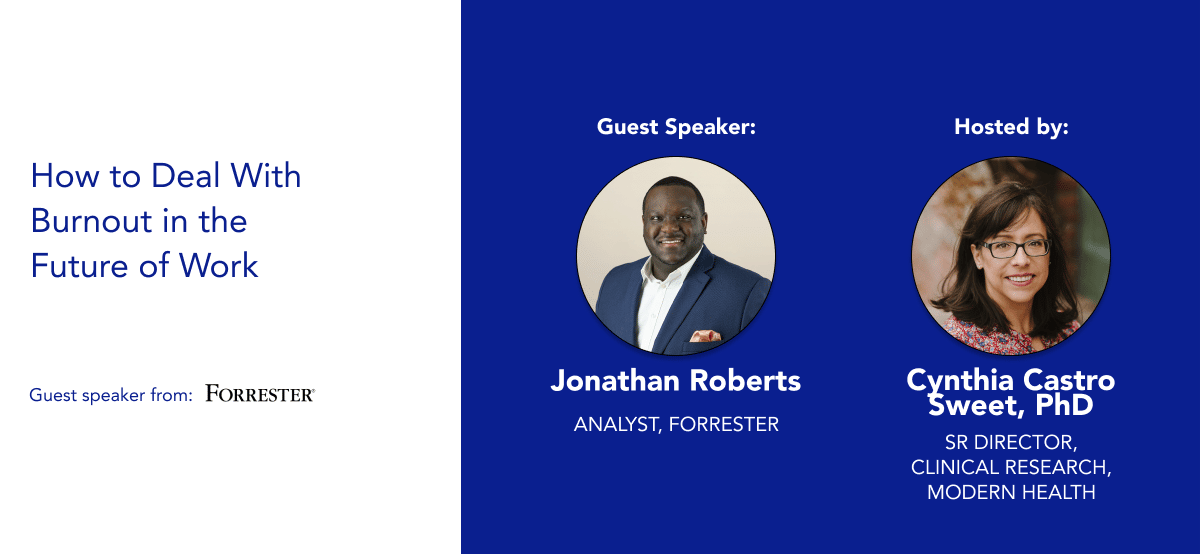
Workplace Burnout
Understanding workplace burnout
Over half the US workforce is currently on the burnout spectrum. According to a 2021 survey by Indeed, 52% of workers surveyed reported experiencing some form of burnout—up 10% from the same survey conducted prior to the COVID-19 pandemic. As stress at home increases—like living through a global pandemic for an indeterminate amount of time—the ability to handle stress at work diminishes, leaving many feeling exhausted and drained in their daily routine. HR Leaders and managers will need to address chronic burnout as a real problem or face negative impacts, including high turnover and lowered productivity. For example, a 2021 NIH study found that for every 1-point increase in reported emotional exhaustion, there is a 12% increase in turnover.
Failure to address burnout doesn’t simply end with your organization losing employees. Left unaddressed, burnout becomes a chronic condition, which you may inherit in new team members. Burnout then becomes a vicious cycle for the individual and the group.
What is Burnout?
Burnout, or burnout syndrome, is the resulting set of symptoms from unaddressed chronic stress—most often stress in the workplace. You can identify burnout by noticing common symptoms in your employees or watching for a sudden transition between stages.
Burnout Symptoms May Include:
- Mental and/or physical exhaustion — Notice if your employees are taking more mental health days than usual. Have they mentioned struggling with sleep or feeling especially tired?
- Feeling cynical about work — How are employees taking feedback from you and others on your team? Do they feel they can’t do anything right? Have they mentioned to you they feel defeated?
- Feeling distanced or disengaged with daily work — Pay attention to how your employees feel about participating in meetings or taking on new projects. Are they ignoring your emails for long periods of time where before they used to respond immediately?
- Decreased efficiency at work — Lower output can be a trackable symptom of burnout across your team. Watch out for too many tight deadlines and emails at strange hours, which can be a sign of an unmanageable workload burning out your team.
Top 5 Drivers of Burnout
The top causes of burnout from workplace stress are:
- Lack of recognition: No one can maintain output levels without validation and praise.
- Organizational change: Employees have a low tolerance for change, constant shifts in processes and leadership can contribute to burnout.
- Ill-equipped managers: Managers may be promoted without being given support for improving their abilities to support their teams, leading to a lack of burnout identification on all sides.
- Corporate politics: Employees outside of the “right circles” may experience increased stress over their performance and success.
- Lack of tools and processes: Additional technological or organizational barriers only further exhaust employees on the brink of burnout. Continual assessment for employee tools is crucial for reducing workplace stress
The Burnout Disconnect
Modern Health commissioned Forrester Consulting to conduct a study on workplace burnout, where they asked 1200+ employees and 500+ HR leaders and C-level executives about their impressions of changing mental health benefits in the workplace.
The results showed a worrying trend for the future of coping with workplace stress. According to the Forrester study, 67% of executive leaders and 54% of HR leaders say they intend to return to their pre-pandemic mental health strategy in the next year—levels of care and resources that simply won’t be enough for the new normal their employees face.
And although 64% of executive leaders reported that they were supporting their managers to identify burnout across departments, 49% of managers surveyed said they didn’t have the tools they needed to help their employees with their mental health. This level of disconnect can lead to burnout among your most valuable workers who are culture carriers and productive employees, a group known as Tired Rockstars.
The challenge with Tired Rockstars is they’re the group organizations rely on to influence culture and perceptions, demonstrate desired behaviors, and set an optimistic tone for the workforce. The more an employee stays in this burnt-out-but-engaged space, the harder those objectives become.
Understand Workplace Burnout with Forrester and Modern Health
To learn the best ways to identify and manage burnout in your employees, you can listen to guest speaker, Forrester Analyst, Jonathan Roberts, and Dr. Cynthia Castro Sweet, Senior Director of Clinical Research at Modern Health, discuss "How to Deal with Burnout in the Future of Work." You'll get an in-depth look at recent workforce burnout research, gain knowledge on how to best support your workforce and learn how to keep Tired Rockstars from running themselves ragged.
.jpg)

